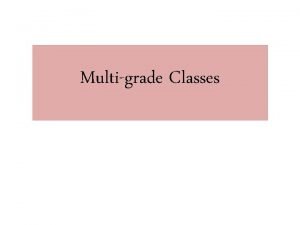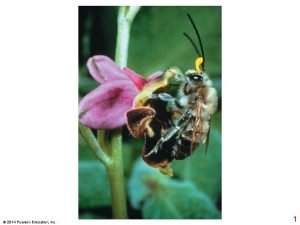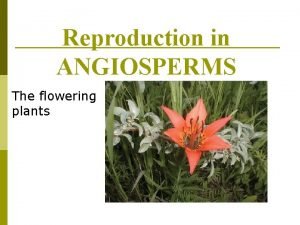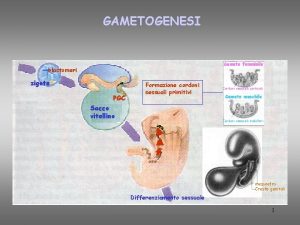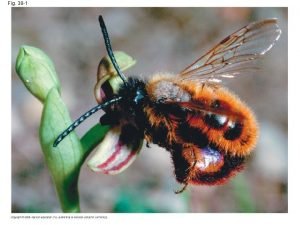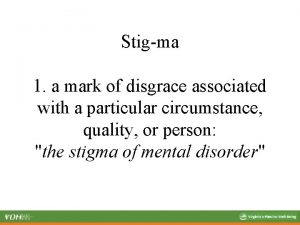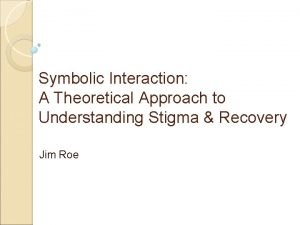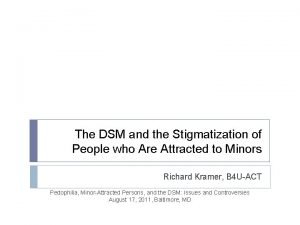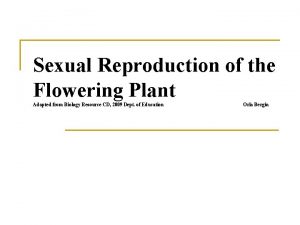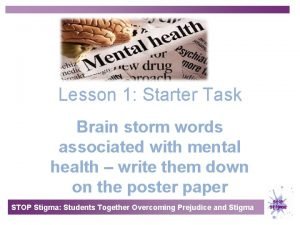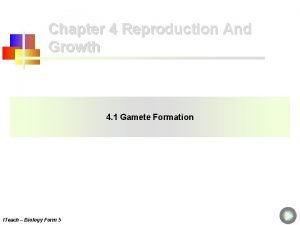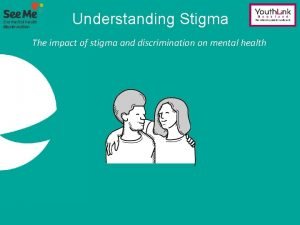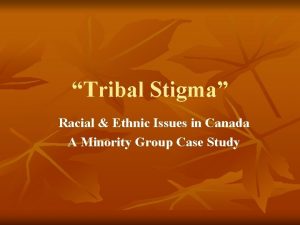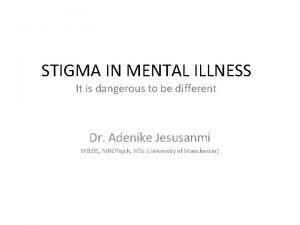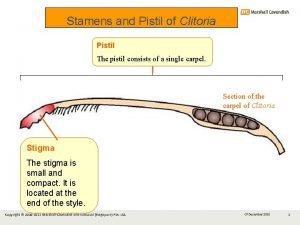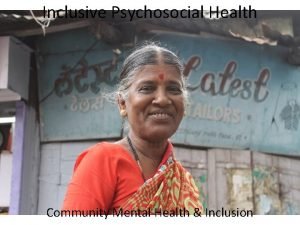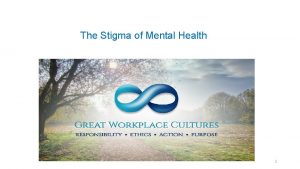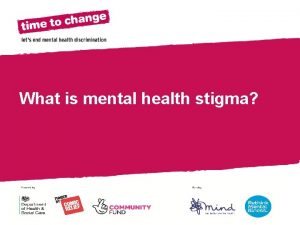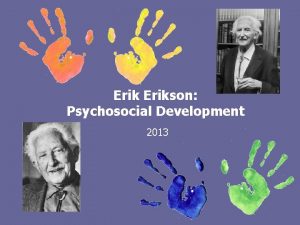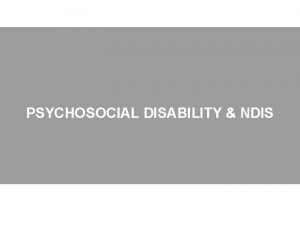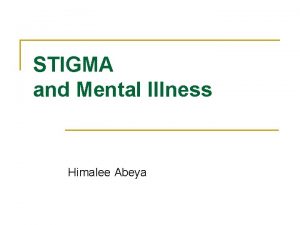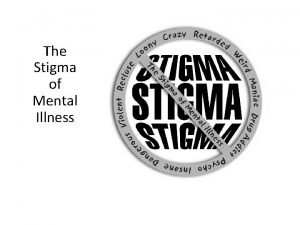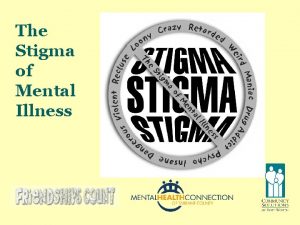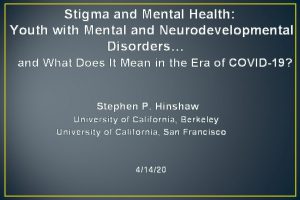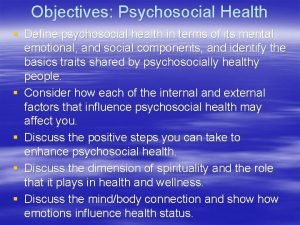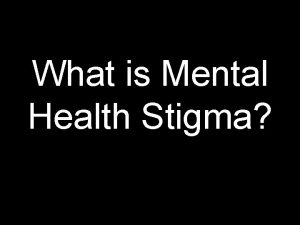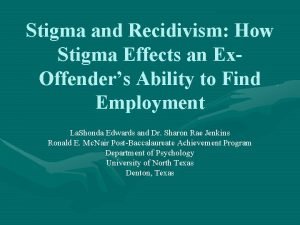Stigma Psychosocial Risk and Core Mental Health Sympotomatology




















- Slides: 20

Stigma, Psychosocial Risk and Core Mental Health Sympotomatology Among Amerasians in the Philippines: A Multiple Case Study _________________________ Dr. P. C. "Pete" Kutschera, Ph. D, LMSW - pkuts 001@waldenu. edu – Amerasian. Institute. org Dissertation Research Review Committee Dr. Marie A. Caputi, Ph. D. , Chair Dr. Monica H. Gordon, Ph. D. Dr. William M. Barkley, Ph. D. College of Social and Behavioral Sciences - Walden University & National Amerasian Research Institute (Provisional)

�Introduction to the Study _______________________________ This research explored the intensity and impact of stigmatization and discrimination among a group of biracial, socioeconomically marginalized African and Anglo Filipino. Americans in Luzon, the Philippines. Study participants are adolescent and young adult progeny of U. S. servicemen abandoned by their fathers when the U. S. Department of Defense (DOD) withdrew long-standing naval, air force, and marine bases in 1991 -92. These children were fathered as a result of military, civilian and DOD contractor personal liaisons with Philippine women including sex industry workers. The study examined stigma- related psychosocial risk and trauma and their cooccurrence and possible relationship to core mental health symptomatology (i. e. , depression, anxiety and stress) employing a researcher developed interview schedule and the Depression Anxiety Stress Scales (DASS-21) measurement inventory. Many risk factors found were stigma-related, including exposure to biracial tension and violence, name-calling, abandonment despair, identity confusion and derivative family strain. Results showed 62. 5% of the sample scored severe levels of core level symptomatology (depression, anxiety or stress} suggesting psychopathology or mental disorder in significant numbers.

�Research Literature Review __________________________________ The review examined origins and history of socioeconomic oppression of Amerasian enclaves in the Philippines (Gastardo-Conaco & Sobritchea, 1999) and other Western Pacific locales including Vietnamese Amerasians (Bemak & Chang, 1997; Mc. Kelvey et al. , 1992, 1993, 1999) and related Amerasian origin themes including impact of colonial and Neo-colonial oppression (C. Johnson, 2004, 2007), military prostitution, (Butler, 2000: Gage, 2007), effects of trauma upon immigrants and refugees (Potocky-Tripodi, 2002) and Pan Amerasian demographics (Gage, 2007; Levi, 1993). History of stigmatization and discrimination among Eurasians (Stonequist, 1937) and stigma and racism's relationship to African Americans in the US (Jackson et al. , 1996; Klonoff, Landrine & Ullman, 1999) and Mexican immigrants and Chicano farm workers in California and Arizona (Hovey & Magana, 2002; Vega et al. , 1998) also were examined. Psychosocial risk factors and impact on mental health among groups historically experiencing stigma, discrimination or racism were examined including African Americans (Lewinsohn et al. , 1994), Mexican migrants, Chicano farm workers and Vietnamese Amerasians. Previous study methodologies of these phenomena were examined primarily among Vietnamese Americans, the only Pan Amerasian grouping to have extensive research conducted on it, including quantitative (Felsman et al. , 1992; Mc. Kelvey et al. , 1992, 1993) and qualitative (Anis, 1996) methodologies.

◦ Methodology _______________________________ An exploratory, multiple-case study design was selected in conjunction with the Stress Process Model - an important feature patterned on the concept that physical risk and mental stress factors directly affect the mental state. Two primary information gathering devices used: (a) a semi-structured, open-ended interview guide data and biographical data questionnaire, and (b) the DASS-21 scales which measures Depression, Anxiety and Stress levels. Data collection was conducted on a sample of 16 youth and young adults. Four sub-groups were divided into two age ranges (ages 16 -18 and 19 -39) of equal numbers of females and Africans and Anglos. The research site, Angeles City, Luzon which has 6, 000 of an estimated 50, 000 Amerasians in the Philippines. The sample was nonclinical (i. e. , not in mental health treatment). Selection was by the purposive method to ensure participants had a reasonable likelihood of encountering stigma because of origin of birth and physical features, or to assure qualities believed typical of the study phenomena (Fortune & Reid, 1999). Data analysis used triangulation (a) evaluating psychosocial risk factors and psychological themes derived from the interview schedule, (b) comparing DASS-21 scores with risk factors and psychological themes, and (c) performing both cross-case, in-case analysis.

◦ Research Results & Findings ______________________________ Relationship Between Risk Factors and Scores on the DASS-21 Cross- case comparison and analysis of DASS-21 severity ratings with risk factors indicated a clear co-occurrence among those participants with severe psychopathological symptomatology (Depression, Anxiety and Stress) and multiples of risk and stress factors. Overall, the results reflected a general pattern that the greater the number of participant psychosocial risk factors, the greater were the mean symptomatology scores. Participants with 8 or more risk factors appeared to cross a threshold and symptomatology scores appeared to climb precipitously. Significantly, the mean for the sample was 9. 93. These findings suggested a possible relationship between these variables in the Filipino Amerasian sample beyond the mere co-occurrence of risk factors with higher symptomatology scores. Generally and statistically speaking for this small Amerasian sample as cumulative numbers of risk factors rose so did core symptomatology levels, a conclusion borne out by Mc. Kelvey et. al. , (1992, 1993) studying Vietnamese Amerasian refugees.

�Research Results and Findings _______________________________ Relationship Between Risk Factors and Scores on the DASS-21

�Research Results and Findings _______________________________ Major Psychological Themes Originally, 19 sub-themes emerged through content analysis of the narrative interview data ultimately sifted and winnowed to a composite total of 3 principal themes based upon consolidation of related sub-themes, their dispersal affecting the widest number of participants, and for the emotion in which they were voiced by the sample: In order of their general sequential emergence during interviews the primary themes were as follows: + Intense Abandonment Construct - "I Miss Him. “ + Stigmatized and Traumatic Exposure: "Why is this Happening to Me? “ + Identity Conflict, Confusion and Loss: "Who Am I? “

�Research Results and Findings

�Research Results and Findings

�Nonconforming, Unanticipated and Divergent Findings Somatic Complaints Derivative Amerasian Family Construct Neutral, Apolitical Views of Oppression “Pan Amerasian” Social Construct Strong Diaspora Features

�Interpretation of Findings ___________________________________ Research Question 1: How did both Filipino Amerasian adults and adolescents describe their lives as they experience social stigmatization and ethnic discrimination ? Essentially on 3 levels: (a) as individuals emotionally, psychologically and socioeconomically, (b) by age group (adolescents or adults), and (c) as identity with the Amerasian Diaspora. The early loss of their fathers and in at least 6 instances both parents was a defining life event, costly SES wise, profoundly emotional, and affected how Amerasians believed they were viewed by the outside world. A number reported symptoms similar to such psychological phenomena of unresolved, complicated grief or more severe psychic loss related to abandonment by their fathers or both parents (Shabad, 1993). Usually in early grade school they learned definitively that they were "different" than fellow classmates or mainstream Filipinos due to skin or complexion color, facial features or hair differences typically resulting in teasing, name-calling, verbal and physical harassment. At least 13 (81%) described living in severe poverty with many attributing such conditions to status as members of African or Anglo Amerasian households, a long term condition affecting many with traumatic impact.

�Interpretation of Findings _________________________________ Research Question 2: Were there indicators that Filipino Amerasians generally experienced stigmatization and discrimination based upon their different racial and ethnic constitution, physical features, and conditions of birth as progeny of U. S. servicemen? The sample majority believed they experienced both stigmatization and discrimination in many crucial aspects of their personal and public lives primarily driven by Filipino society and based upon their physical features, social circumstances at birth including mixed- parentage, and resultant low SES. Some reported they were stigmatized in the early years if their mothers were prostitutes or suspected of engaging in sex industry pursuits by other family members, neighbors or classmates. Some said they were held accountable throughout their lives because of their mother's involvement in the sex industry and claims that their fathers were ashamed of them and subsequently abandoned them. Both Anglos and Africans experienced heavy name-calling and verbal harassment beginning in their early grade school years and continuing into adulthood mostly based on their physical appearances or circumstances at birth. Both Anglos and Africans described these episodes as highly traumatizing and many speculated such conditions impacted negatively on their mental or physical health. Many Amerasians repeatedly witnessed schoolyard bullying, street gang attacks, intra-family abuse, or general violence directed at Amerasians’ friends or acquaintances largely based on stigmaladen and discriminatory behavior.

�Interpretation of Findings _________________________________ Research Question 3: Were there indications that African Americans experienced greater degrees of stigmatization, discrimination and low SES marginalization based upon the presenting conditions described above? African Amerasians stated with almost universal Anglo corroboration that Africans were more frequently stigmatized and discriminated against by mainstream Filipinos. Interviews and computations from psychosocial risk and stress factors bore out that Africans experienced greater degrees of stigma, discrimination, impoverishment, lower social desirability, and experienced greater rejection, social isolation and feelings of inferiority than Anglos. Confirmation from the DASS-21 indicated Africans experienced higher levels of psychopathological symptomatology in each of the three subscales (Depression, Anxiety and Stress). Adult Africans (n=4) were the most vulnerable sub-group in the sample followed by women and specifically African women in both age categories. Africans experienced slightly higher levels of economic impoverishment than Anglos and slightly more severe levels of housing insecurity and homelessness. Name-calling and verbal harassment was more intense when directed against Africans with particular emphasis on provocative references to one's physical appearance and phenotypic features (e. g. , "fat lips"; "black hole"; "nigger"; "black monkey"; "slave" and "Kulot" or one with kinky hair.

�Interpretation of Findings ____________________________ Research Question 4: Did Amerasians view their circumstances of birth as a contributing factor to their psychosocial, SES and general mental health well-being ? Participants readily made personal connections between circumstances surrounding their unique birth circumstances as Amerasians and their current marginal SES and psychosocial conditions. The sample generally acknowledged that many of the difficulties encountered in their youth, such as being of mixed parentage, experiencing the loss of financial and emotional support from the father within the family unit, and being biracial within the dominant Filipino society contributed to emotional difficulties at various life stages. Their perceptions of how these conditions historically developed in a sociopolitical sense was unclear or unknown to them and their knowledge of the historical circumstances surrounding the formation of military prostitution, income and class inequity and other trappings of colonial and post and neo-colonial structuring was minimal. The sample did not perceive the conditions that Fanon (1963, 1965) prescribed as precursors of psychological oppression. The sample did not to any appreciable degree express notions or knowledge of colonizer authoritarianism, human exploitation, alienation, oppressor-driven stigmatization or SES depravation in the sociopolitical sense as outlined by Fanon.

�Interpretation of Findings ____________________ Research Question 5: Was there a presence of stigmatization and discriminationrelated psychosocial stress factors experienced by Filipino Amerasians and depression, anxiety and stress (i. e. , core elements of psychopathological symptomatology)? Primarily, distinct and cumulatively elevated levels of anxiety and depression; secondarily, less but nevertheless noteworthy, levels of stress presented among a majority of participants. There was a discernable if not clear pattern of co-occurrence of aggregated stigmatization and discrimination-related psychosocial risk and stress factors with progressively elevated anxiety and depression levels. There was evidence of severe or extremely severe levels of symptomatic anxiety, depression or stress (n=10, or 62%), suggesting, though not confirming, the occurrence of mental disorder, not an objective of this study. This research approximated similar findings revealing mental health risk and stress and the potential for future development of psychopathology in a number of empirical field studies among Vietnamese Amerasian refugees conducted in the 1980 s and early 1990 s.

�Recommended Governmental Action U. S. Department of Defense Responsibilities & Challenges +Control of troops, federal [and private sector] employees. +Enforcement of UCMJ – Article 134 legal restrictions. U. S. Initiatives Domestic & Abroad +Easement of Immigration Barriers to U. S. +Review of Amerasian Visa [I-360] Embassy Checklist +Revisiting the 1987 Amerasian Homecoming Act

�Recommendations for Social Action ______________________ Therapeutic Psychiatric & Social Work Treatment Initiatives Recognition of Amerasian Issues by Academia Research Strategy Plans & Options Non-Profit, Foundation & NGO Support

�Recommendations for Further Research _______________________________ Open Research Opportunities Statistically Enhanced Sample Needed - in Numbers & Geographical Dispersal Aspects of Unresolved, Complicated, Residual Grief & Psychic Loss among Filipino Amerasians The ‘Derivative Amerasian Family’ Construct. Implications of Somatic Complaints & Illness Among Filipino Amerasians. Demographic Research – the empirically untested 50, 000 Filipino Amerasian Claim? The ‘Pan Amerasian’ Diaspora Social Construct (Philippines, S. Korea, Okinawa, Thailand, Guam, Vietnam, Afghanistan , etc. ) The ‘New Face’ of Philippine Amerasia 2011 & Beyond.

Closing Thoughts: "Perhaps we cannot prevent this world from being a world in which children are tortured. But we can reduce the number of tortured children. And if you don't help us, who else in the world can help us do this? " --Albert Camus “Salamat” to the Philippine Children’s Fund of America, Director Erik D. Gomez, and the committed PCFA Staff – Without your cooperation this research would not have been possible! http: //vimeo. com/16703711

Stigma, Psychosocial Risk and Core Mental Health Symptomagology Among Amerasians in the Philippines: A Multiple Case Study Dr. P. C. “Pete” Kutschera, Ph. D. – Amerasian. Institute. org – E-mail: Dr. K@amerasianinstitute. org or USA Tel. (518) 4383538 * Phil CP# 0949 -631 -3092 – For a no-cost pdf. file copy of the 266 -page research: www. Amerasian. Institute. org/dissertation
 Mental health and mental illness chapter 20
Mental health and mental illness chapter 20 Mental illness mental health jeopardy
Mental illness mental health jeopardy Credit risk market risk operational risk
Credit risk market risk operational risk What is multigrade
What is multigrade Inc
Inc Pollen picks
Pollen picks Picture of part of plant
Picture of part of plant Follicolo preantrale
Follicolo preantrale Hypocotyl and epicotyl
Hypocotyl and epicotyl The mark
The mark Stigma image
Stigma image Associatief stigma
Associatief stigma Symbolic stigma
Symbolic stigma Stigma image
Stigma image Fruits and seeds formation
Fruits and seeds formation Stigma image
Stigma image Stigma bunga
Stigma bunga What is stigma
What is stigma Tribal stigma
Tribal stigma What is stigma
What is stigma Pistil
Pistil



